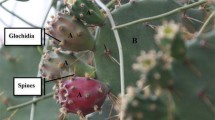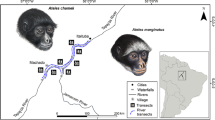Summary
The seeds in fruits consumed by primates may be chewed and digested, swallowed and defecated intact, or separated from the flesh and spat out. We show by a combination of close field observations and experiments with caged animals, that long-tailed macaques (Macaca fascicularis) have a remarkably low threshold of 3–4 mm for swallowing seeds and also that wild macaques rarely break them. The seeds of 69% of the ripe fruit species eaten are spat out intact or cleaned outside the mouth and dropped. Seed-spitting significantly reduces the swallowed food bulk and may lessen the risk of releasing seed toxins during mastication. However, it requires that even small fruits are processed in the mouth one or a few at a time. We suggest that fruit storage in the cheek pouches of cercopithecine monkeys allows them to spit seeds individually without excessively slowing fruit intake while feeding on patchily distributed fruit. In contrast, Apes and New World monkeys apparently swallow and defecate most ripe seeds in their diet and colobine monkeys break and digest them, detoxifying seed defenses by bacterial fermentation.
Similar content being viewed by others
References
Bauchop J, Martucci RW (1968) Ruminant-like digestion of the langur monkey. Science (Wash., D.C.) 161:698–700
Bell EA (1984) Toxic compounds in seeds. In: Murray DR (ed) Seed physiology, vol 1, Development. Academic Press, Sydney, pp 245–264
Bennett EL (1983) The banded langur: ecology of a colobine in West Malaysian rain-forest. PhD thesis, University of Cambridge
Cant JGH (1988) Positional behaviour of long-tailed macaques (Macaca fascicularis) in northern Sumatra. Am J Phys Anthropol 76:29–37
Clutton-Brock TH (1977) Methodology and measurement. In: Clutton-Brock TH, Harvey PH (eds) Primate ecology. Academic Press, New York, pp 585–590
Corlett RT (1988) Bukit Timah: history and significance of a small rain-forest reserve. Environ Conserv 15:37–44
Corlett RT (1989) Flora and reproductive phenology of the rain forest at Bukit Timah, Singapore. J Trop Ecol (in press)
Davies AG, Baillie IC (1988) Soil-eating by red leaf monkeys (Presbytis rubicunda) in Sabah, Northern Borneo. Biotropica 20:252–258
Davies AG, Bennett EL, Waterman PG (1988) Food selection by two South-east Asian colobine monkeys (Presbytis rubicunda and Presbytis melalophos) in relation to plant chemistry. Biol J Linn Soc 34:33–56
Estrada A, Coates-Estrada R (1984) Fruit eating and seed dispersal by howling monkeys (Alouatta palliata) in the tropical rain forest of Los Tuxtlas, Mexico. Am J Primatol 6:77–91
Foster SA, Janson CH (1985) The relationship between seed size and establishment in tropical woody plants. Ecology 66:773–780
Galdikas BMF (1982) Orang Utans as seed dispersers at Tanjung Puting, Central Kalimantan: implications for conservation. In: Boer LEM (ed) The orang utan. Its biology and conservation. Junk, The Hague, pp 285–298
Garber PA (1986) The ecology of seed dispersal in two species of callitrichid primates (Saguinus mystax and Saguinus fuscicollis). Am J Primatol 10:155–170
Gautier-Hion A (1980) Seasonal variations of diet related to species and sex in a community of Cercopithecus monkeys. J Anim Ecol 49:237–269
Gautier-Hion A (1984) La dissemination des graines par les cercopithecines forestiers africains. Rev Ecol (Terre Vie) 39:159–165
Happel R (1988) Seed-eating by West African cercopithecines, with reference to the possible evolution of bilophodont molars. Am J Phys Anthropol 75:303–327
Howe HF (1980) Monkey dispersal and waste of a tropical fruit. Ecology 61:944–959
Howe HF (1986) Seed dispersal by fruit-eating birds and mammals. In: Murray DR (ed) Seed dispersal. Academic Press, Sydney, pp 123–189
Idani G (1986) Seed dispersal by pygmy chimpanzees (Pan paniscus): a preliminary report. Primates 27:441–447
Jackson G, Gartlan JS (1965) The flora and fauna of Lolui Island, Lake Victoria. A study of vegetation, men and monkeys. J Ecol 53:573–597
Janson CH (1984) Capuchin-like monkeys. In: Macdonald D (ed) The encyclopaedia of mammals, 1. Allen and Unwin, London, pp 352–357
Janson CH, Stiles EW, White DW (1986) Selection on plant fruiting traints by brown capuchin monkeys: a multivariate approach. In: Estrada A, Fleming TH (eds) Frugivores and seed dispersal. Junk, Dordecht, The Netherlands, pp 83–92
Janzen DH (1978) The ecology and evolutionary biology of seed chemistry as relates to seed predation. In: Harborne JB (ed) Biochemical aspects of plant and animal coevolution. Academic Press, London, pp 163–206
Janzen DH (1981a) Digestive seed predation by a captive Costa Rican Baird's tapir. Biotropica [Suppl] 13:59–63
Janzen DH (1981b) Enterolobium cyclocarpum seed passage rate and survival in horses, Costa Rican Pleistocene dispersal agents. Ecology 62:595–601
Janzen DH (1983a) Physiological ecology of fruits and their seeds. In: Lange OL, Nobel PS, Osmond CB, Ziegler H (eds) Physiological plant ecology III (Encyclopaedia of Plant Physiology, NS, vol 12C). Springer, Berlin Heidelberg New York, pp 625–655
Janzen DH (1983b) Dispersal of seeds by vertebrate guts. In: Futuyma DJ, Slatkin M (eds) Coevolution. Sinauer, Sunderland, Mass., pp 232–261
Leighton M, Leighton DR (1983) Vertebrate responses to fruiting seasonality within a Bornean rain forest. In: Sutton SL, Whitmore TC, Chadwick AC (eds) Tropical rain forest: ecology and management. Blackwell, Oxford, pp 181–196
Levey DJ (1987) Seed size and fruit-handling techniques of avian frugivores. Am Nat 129:471–485
Lieberman D, Hall JB, Swaine MD (1979) Seed dispersal by baboons in the Shai Hills, Ghana. Ecology 60:65–75
Lindburg DG (1971) The rhesus monkey in North India: an ecological and behavioral study. In: Rosenblum LA (ed) Primate behavior: developments in field and laboratory research, II. Academic Press, New York, pp 1–106
McKey DB, Gartlan JS, Waterman PG, Choo GM (1981) Food selection by black colobus monkeys (Colobus satanus) in relation to plant chemistry. Biol J Linn Soc 16:114–146
Milton K (1984) Habitat, diet, and activity patterns of free-ranging woolly spider monkeys (Brachyteles arachnoides E. Geoffroy 1806). Int J Primatol 5:491–514
Moermond TC, Denslow JS (1985) Neotropical frugivores: patterns of behavior, morphology, and nutrition with consequences for fruit selection. In: Buckley PA, Foster MS, Morton ES, Ridgely RS, Smith NG (eds) Neotropical ornithology (Monograph 36). American Ornithologists' Union, Washington, DC, pp 865–897
Murray P (1975) The role of cheek pouches in the cercopithecine monkeys adaptive strategy. In: Tuttle RH (ed) Primate functional morphology and evolution. Aldine, Chicago, pp 151–194
Rowell TE (1984) Guenons, macaques and baboons. In: Macdonald D (ed) The encylopaedia of mammals, 1. Allen and Unwin, London, pp 370–381
Schaik CP van, Noordwijk MA van (1985) Evolutionary effect of the absence of felids on the social organisation of the macaques on the island of Simeulue (Macaca fascicularis fusca, Miller 1903). Folia Primatol 44:138–147
Smith CC, Reichman OJ (1984) The evolution of food caching by birds and mammals. Annu Rev Ecol Syst 15:329–351
Takasaki H, Uehara S (1984) Seed dispersal by chimpanzees: supplementary note 1. Afr Stud Monogr 5:91–92
Terborgh J (1985) The ecology of Amazon primates. In: Prance GT, Lovejoy TE (eds) Key Environments, Amazonia. Pergamon, Oxford, pp 284–304
Tutin CEG, Fernandez M (1985) Foods consumed by sympatric populations of Gorilla g. gorilla and Pan t. troglodytes in Gabon: some preliminary data. Int J Primatol 6:27–43
Van Roosmalen MGM (1980) Habit preferences, diet, feeding strategy and social organisation of the black spider monkey (Ateles paniscus paniscus Linnaeus 1758) in Surinam. Doctoral dissertation, Rijksuniversiteit voor Natuurbeheer, Leersum
Whitten AJ (1982) Diet and feeding behaviour of kloss gibbons on Siberut Island, Indonesia. Folia Primatol 37:177–208
Wolfheim JH (1983) Primates of the world. University of Washington Press, Seattle
Author information
Authors and Affiliations
Rights and permissions
About this article
Cite this article
Corlett, R.T., Lucas, P.W. Alternative seed-handling strategies in primates: seed-spitting by long-tailed macaques (Macaca fascicularis). Oecologia 82, 166–171 (1990). https://doi.org/10.1007/BF00323531
Received:
Accepted:
Issue Date:
DOI: https://doi.org/10.1007/BF00323531




